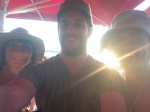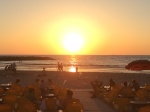An editorial note: I cannot overstate how difficult it is to write on an issue and place as an outside observer. For this reason, I find myself leaning towards a mystical and transcendent tone. There is no way that we are in neutral ground or giving a balanced viewpoint, for so many reasons. It is one of the struggles every writer must face: thinking of how your audience will receive something, yet writing what you want to, with the words you want to use, even when provocative or biased (again, students, journalism deals with this tension but it is a different bear–we will learn from Ms. Giesler together). Even though I am an outsider, but because I am an artist, and arguably because of my common humanity, I am a participant. So, here is another vignette–one that reads less like a story and more like prose or poetry–of hopefully several more to come:
Another editorial note: This is draft 1b. One of my biggest weaknesses as a writer (some may say a strength) is that I intensely and perfectionistically revise as I write, which means that though this is my first draft and will take it through a longer process of revising and editing, I wrote it with the self-inflicted burden of the desire to write something immediately publishable. In this vein, feel free to give me feedback! – katie
Blue is the color of the noonday’s sky, fading into its deeper shade of the Mediterranean. It is the color of ocean waters at every earthly bay and the color of the wide sky over every child. If blue were a sound, it may be the swooshing of these waves, softly rolling in, harshly clashing with the inlet’s rocks protruding. If blue were a state of being, it is this restful calm. Heaven knows we need this canopy of peace. If only peace were its effect.
It didn’t take long to realize that peace had become an empty notion, a cuss word to some. “I don’t believe in peace,” she said. Just the word felt oppressive, like the anesthetic pacification of true justice. It carried the connotation of concession, of giving up and giving in. She was sixteen, weaving in and out of impassioned conversation with me and texting her friends. Blue was the color of the sign in the ruins of a Palestinian village that narrated a lens of history she did’t agree with, producing visible anger that she seemed to carry around in her youthful ancient memory. “This is not even how this happened. That didn’t happen,” the other girl said, as if physically pushing away the blue sign as she walked on.
She wanted to tell me about the other’s flag. The blue stripes- blue to represent the two rivers and their declaration to occupy all the land in between. All three of their faces were determined, frustrated, sincere. This is their deeply settled story, reinforced by encroaching settlements of the “other”, by blue signs everywhere, by the official presence of blue that is compounding and swallowing up their hope.
Black- is black a color or just the absence of color, whose neutral opposite is white?In their own flag, black is the non-color of battles, death, loss. It pushes up against the white triangle of the hope of peace.
Black is the non-color of the water tanks on the tops of homes in the Arroub refugee camp, which only is allotted water access a few days a week most months of the year. Their story is that it’s one of many efforts to make life unpredictable, unsustainable, unbearable. To create absence, just like the non-color of black is absence, and then replace this black with blue.
Blue is the color of the human-herding gates in one of the 522 permanent checkpoints in the West Bank. Blue is the color of my passport that relieved me of the harassment the Arab woman in front of me faced. The color of my skin is not irrelevant, either. Blue is the color of the I.D. card that denotes those who never fled their home in now-Israel, giving them something of the resident-alien-status sort–the right to pass freely, if you can call that freedom.
Black is the exclusive non-color of the Ultra Orthodox dress. Black suits, black top hats or black kippahs, black shoes, black beards and black curled hair strands in the front of their black-on-white shaved heads. In one enlightened window of history, it was the standard of formal dress of the public, instituted from henceforth to level the playing field for the Yeshiva youth, proclaiming human greatness for all (but only in the exclusive sense, of course). But who remembers that? Now it is as it is, crystalized in the blessing and curse-or beauty and danger, if you will–of tradition. Perhaps black is the color of tradition. As you walk through the streets of the Ultra Orthodox neighborhoods, there are shoe stores of all black shoes, kiosks of all black skirts and cloaks, and little ones in identical black dress running around in the universal way that children do, joking and playing. Black-this was the costume of the man from the Ultra Orthodox settlement who got caught in barbed wire, climbing the fence to take down the Palestinian flag raised on a roof in their own territory. Perhaps black is the absence of empathy, allowing the presence of fear to swell in.
Black- the color of Ethiopian Jews who came in droves to Israel in the 1970s and 80s, recruited to return home to the Promised Land. But, we all know the story of utopias. Humans impossibly cling to hierarchy–a real knack for creating an “other.” Who ever said it was us against them? It’s us against us.
Blue is the color of the 1, 2, or 4 of the tassels, tzitit, on the traditional white Jewish prayer shawl, the tallit. The blue dye comes from the hillazon, a rumored sea creature that surfaced on the shores of Israel once every 70 years. The blue tassels are wool, one of the only garments in which wool is allowed to interlock with linen, according to Torah law. Blue was the color of the royal courts during the time of Moses, its turquoise hue mirroring that of the gulf of Aqaba.
As he says this is the real story of Israel’s flag, not the one about the rivers, I wonder what makes a story real.
Some rabbinic wisdom professes that blue is the color of God’s glory. I wonder if the teaching is to wield it or to simply watch it.
Black and blue are the self-inflicted wounds of unknowing, as well as the bruises of loss, perseverance, even love–battle wounds to boast of, yet from a battle, nonetheless.

